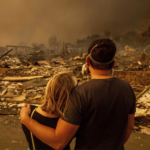In recent history, aviation safety has faced heightened scrutiny due to a series of alarming incidents, such as the September 11 attacks, which were a series of coordinated terrorist attacks by Al-Qaeda on the United States, resulting in nearly 3,000 deaths. These horrific and tragic attacks prompted significant changes in plane security worldwide, leading to the implementation of stricter security measures, such as reinforced cockpit doors, increased passenger screenings, and enhanced security protocols to prevent similar hijackings in the future. Along with this event that forever altered the nation’s view on plane security, the government also used this event as a wake-up call, choosing to be more careful when looking into people’s luggage, making people take their shoes off when scanning their bodies, and many more preventative actions. Not only were people checked more carefully, but it also caused a sense of vulnerability due to the lack of care that planes get when getting ready to safely handle the lives of hundreds of people at a time. Failed landings, wings being violently ripped off, weather conditions, and even lack of breathable air or fuel inside the plane itself are all reasons why planes can cause major issues and trauma in the aviation industry, causing a stigma for flying and trauma for ones who need to get from place to place safely.
Safety has taken a major turn for the better through cautious inspections of all measures when flying. It has ultimately led to the precedent of double-checking in every action made in everyday life. When thinking about the fact that perfection is unrealistic, that’s when accidents come into play, including the more recent Alaskan airline mishap that occurred on January 5th, 2024. The flight took off at 5:06 PM in Portland International Airport on the way to Ontario, California, carrying 177 people on board. After a quick and seemingly easy takeoff, many complained of hearing a “loud bang” as the plane started to go up steadily, yet flight attendants played it off as no big deal. The flight began to head southbound through the cool air of the West Coast during this chilly winter. Six minutes into the flight, as many just began to put in their headphones for a mid-flight nap or to eat food bought in the terminal, the entire emergency door plug blew off viciously on the left side of the plane in Row 18, leaving a gaping hole in the side of the aircraft thousands of feet into the air. Unintentionally, for the rest of the duration of the flight that ended up touching back down at Portland International Airport at 5:30 PM, the plane was left with nothing but shocked and traumatized passengers staring at the bright, vast hole with a bulging sunset and strong winds ready to snatch you down the suffocating atmosphere to the city of Portland. Immediately following this extremely stressful incident, many began to sue Boeing and Alaskan Airlines for injury and trauma-related effects from this scene, digging aviation into an even deeper hole.
These frightening events serve as stark reminders of the complex challenges inherent in ensuring the safety and reliability of air travel. The Alaskan airline incident, where a plane experienced engine failure shortly after takeoff, underscores the critical importance of robust maintenance procedures and rigorous safety protocols. Such incidents not only jeopardize the lives of passengers and crew but also highlight the potential consequences of equipment malfunction in the aviation industry. In response to these events, aviation authorities and industry stakeholders must continuously assess and improve safety measures, including enhanced training for pilots and maintenance personnel. Furthermore, collaboration between airlines, manufacturers, and regulatory bodies is essential to identify and address systemic issues that may compromise safety standards. Ultimately, a proactive approach to risk management and a steadfast commitment to safety is imperative to instill confidence in air travel and prevent future incidents.







